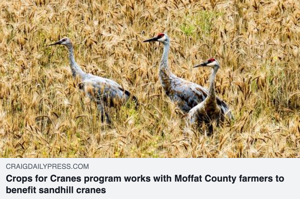Crops for Cranes
A priority program of the Colorado Crane Conservation Coalition (CCCC) that works to establish designated areas where grain crops will be left for Sandhill Cranes during late summer and fall prior to their migration.
Crops for Cranes works with willing ranchers, farmers, conservation organizations, and landowners to support cranes and the ranching community.
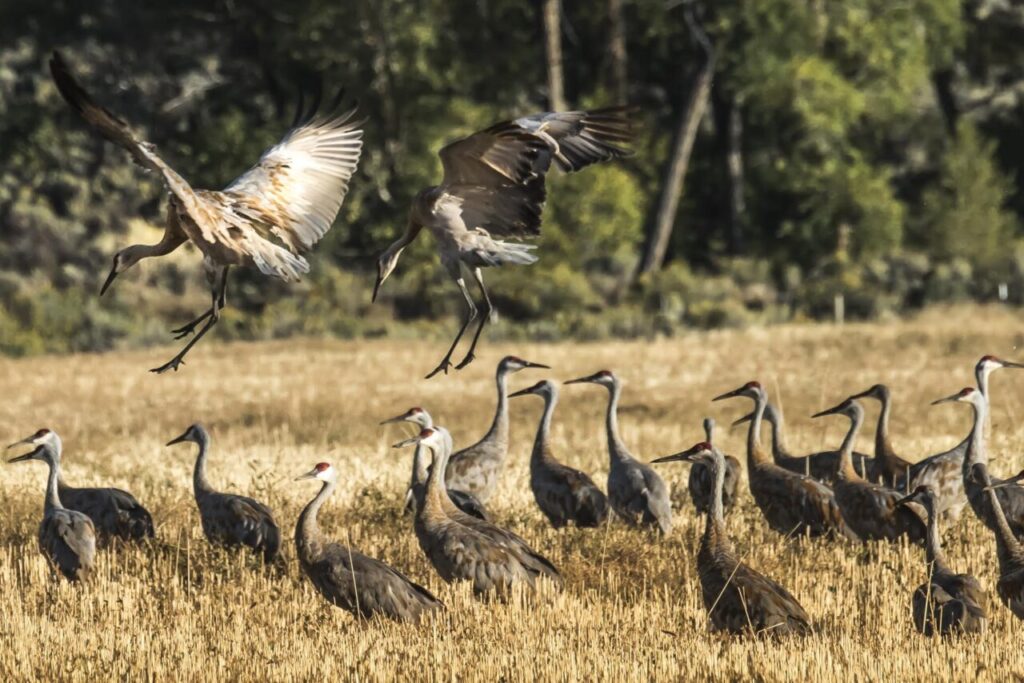
PROJECT GOALS
- Ensure an adequate food supply for cranes during the critical staging season in late summer/early fall
- Establish a predictable area where the public and crane festival attendees can observe cranes without disturbing them and without trespassing on private property
HOW IT WORKS
CCCC will enter into an individualized, multi-year agreement with the landowner to grow and leave an agreed-upon number of acres of grain crops for the cranes. The exact location of the crop area is determined mutually between the landowner and CCCC. The crop in this area is either harvested in late August or early September, or it is left standing for the cranes.
Benefit to Farmers
Flexible program options, including monetary incentive from CCCC
Benefit to Cranes
Vital source of nutrition prior to and during fall migration
Benefit to the Public
Reliable viewing of large flocks of Sandhill Cranes
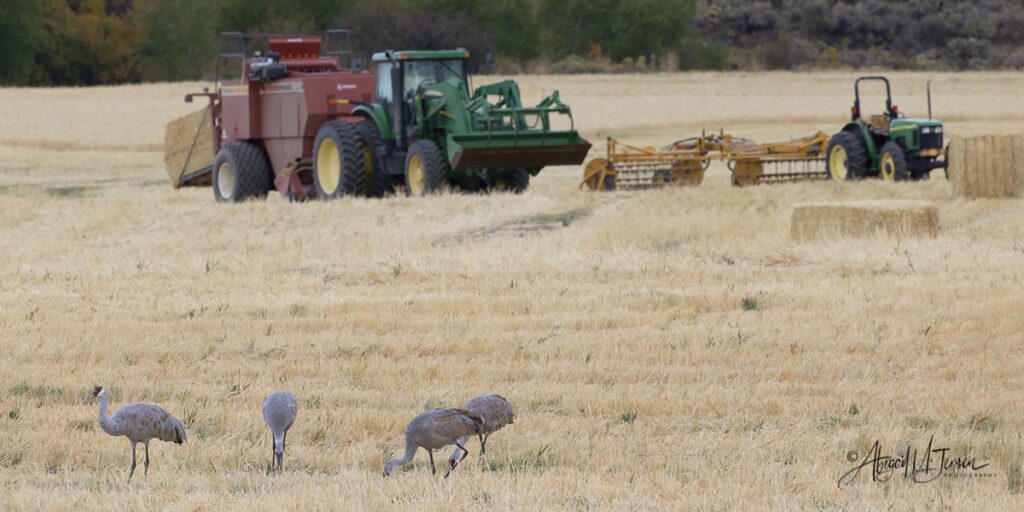
BACKGROUND
Cranes in the Yampa Valley
Greater Sandhill Cranes breed and stay in the Yampa Valley all summer long until their chicks are big enough to migrate south. Cranes that breed here and cranes that breed in other areas of the Rocky Mountains join together in this “staging area’ for several weeks in late summer and early fall before migrating south for the winter. Cranes are attracted to the Yampa Valley because of:
- Presence of the Yampa River and abundant wetlands that provide roosting areas
- Irrigated hay meadows that provide food (insects, frogs, plants) for the omnivorous cranes
- Harvested grain fields that provide waste grain, a favored source of food at this time of year that provides nutrition needed for southern migration
Agricultural Trends
In recent years, agricultural trends have undergone a significant change in the Yampa Valley largely due to economic factors. The production of local grain crops (wheat, oats, and barley) has decreased from approximately 85,000 acres in the 1940’s to less than 10,000 acres currently. This means there is less food for the cranes during the staging season when cranes (especially the young of the year) need adequate nutrition for successful migration to their winter homes. If grain production continues to decrease, cranes may spend less time in the Yampa Valley and may eventually leave the area altogether. This would be a huge loss for the valley’s biodiversity and for the ecotourism that the cranes generate.
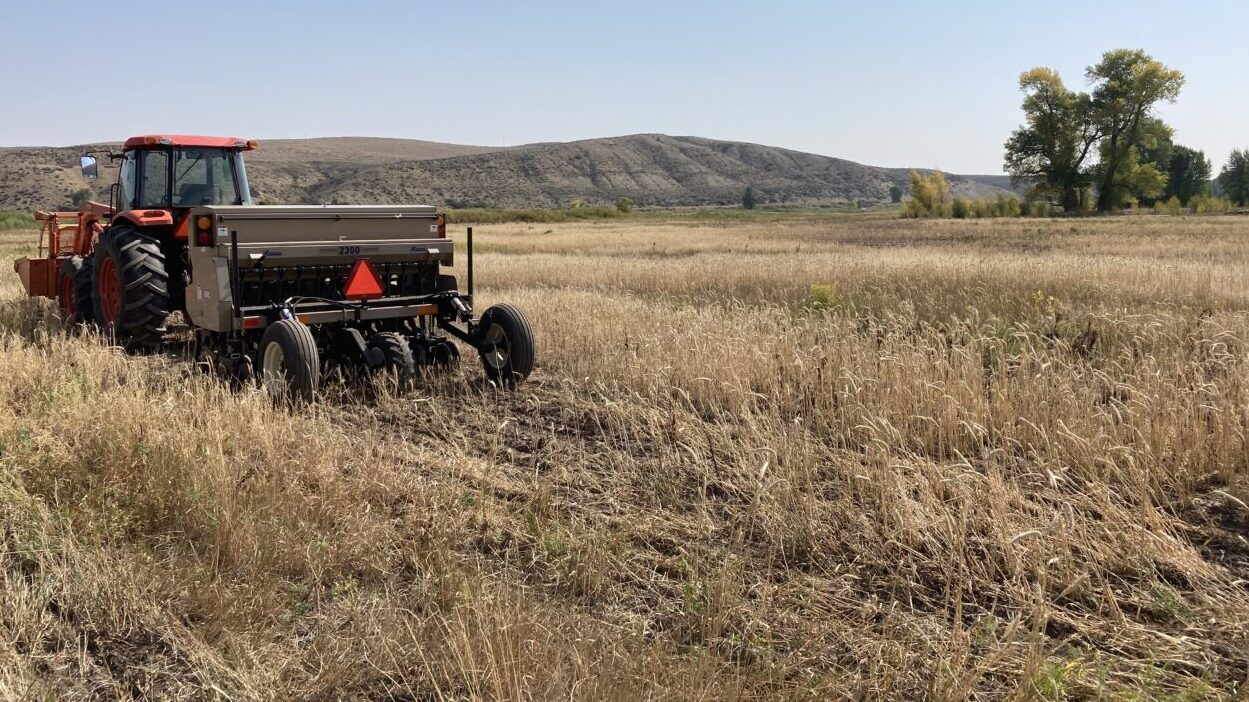
About Crops for Cranes
Since 2015, the Colorado Crane Conservation Coalition (CCCC) has been working with state wildlife officials, conservation organizations, and private landowners to provide grain crops for cranes in the late summer/early fall, just prior to their migration and coinciding with peak numbers of staging (or gathering) Sandhill Cranes.
Cranes appear to favor feeding in grain fields that have recently been harvested. Through Crops for Cranes, CCCC helps provide food for the staging cranes, which in turn provides greater predictability for crane viewing, while simultaneously providing monetary benefits to our partners who plant and harvest the grain.
Crane Viewing
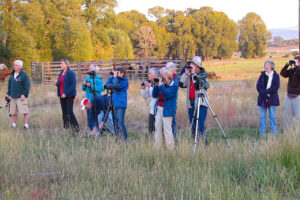
Yampa Valley Crane Festival attendees viewing Sandhill Cranes.
Viewing Sandhill Cranes during fall staging plays a critical role in educating the public about cranes, the environment, conservation, and the important role that agriculture plays with wildlife. The annual Yampa Valley Crane Festival is CCCC’s most important program for educating the public about cranes. During the festival, CCCC brings people to grain fields to get a first-hand experience of the cranes eating, dancing, and socializing. The Crops for Cranes program helps establish designated areas that allow for reliable, safe public viewing of cranes.
VIDEOS
Cranes and Agriculture in the Yampa Valley Agriculture and Greater Sandhill Cranes are mutually important aspects of the Yampa Valley. Ranchers discuss their views of cranes, their agricultural practices, and how some are implementing new practices to benefit cranes in the Yampa Valley. By Laura Foulk, Barb Hughes, and Nancy Merrill. Filmed by Barry Kaplan and Erin Gelling. Edited by Erin Gelling.
Crops for Cranes Learn about this innovative program in which Yampa Valley farmers and ranchers work together with CCCC to help the cranes and the crane festival. By Laura Foulk and Barb Hughes. Filmed by Barry Kaplan and Erin Gelling. Edited by Erin Gelling.
NEWS ARTICLES
Craig Daily Press. Click here to read an article published March 16, 2018 in the Craig Press newspaper about progress in our “Crops for Cranes” program.
Funding
The Crops for Cranes program is funded through private donations and grants.
Contact Us
If you are interested in this program and want to learn more, contact us:
Email: [email protected]
Phone: (970) 276-1933
We will set up a meeting to learn more about your goals, answer any questions, and discuss if Crops for Cranes is right for you.
